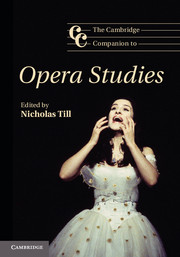Book contents
- Frontmatter
- Contents
- Contributors
- Acknowledgements
- Introduction: opera studies today
- Part One Institutions
- Part Two Constituents
- 4 ‘Too much music’: the media of opera
- 5 Voices and singers
- 6 Opera and modes of theatrical production
- 7 Opera and the technologies of theatrical production
- Part Three Forms
- Part Four Issues
- Further reading
- Index
- References
5 - Voices and singers
from Part Two - Constituents
Published online by Cambridge University Press: 05 December 2012
- Frontmatter
- Contents
- Contributors
- Acknowledgements
- Introduction: opera studies today
- Part One Institutions
- Part Two Constituents
- 4 ‘Too much music’: the media of opera
- 5 Voices and singers
- 6 Opera and modes of theatrical production
- 7 Opera and the technologies of theatrical production
- Part Three Forms
- Part Four Issues
- Further reading
- Index
- References
Summary
The singer is the defining feature of opera: the living crucible in which music, drama and spectacle coalesce into a single art form. The history of opera was thus shaped in part according to changing concepts about the singer – about his or her relationship with each of opera’s constituent arts; about ideas of vocal and dramatic virtuosity; about the singer’s place within the hierarchy of the opera house and the gaze of the spectator. In the discourses around opera, the singer is considered both as an embodied musical performer, and also in more abstract terms as pure ‘voice’. Modern opera studies draws on both aspects in its exploration of the singer’s art and performance practice, the social history of the singer, and the investigation of the singer as cultural phenomenon.
Initially, however, the singer was largely ignored during the awakening of critical interest in opera in the 1980s. Despite an opening article by John Rosselli in the first edition of the Cambridge Opera Journal in 1989, it was not until the mid-1990s that English-language scholarship began to take the same interest in the singer as was already evident in continental Europe, albeit from rather different methodological perspectives. This chapter explores various aspects of both historical and contemporary approaches to the singer in relation to voice, text, spectacle, technology, the operatic market place and the audience.
- Type
- Chapter
- Information
- The Cambridge Companion to Opera Studies , pp. 117 - 138Publisher: Cambridge University PressPrint publication year: 2012
References
- 1
- Cited by

